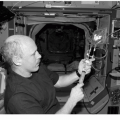Endocrine System and Nephrology
Paula A. Corrigan
Curtiss B. Cook
Balance, to my mind, is the key word.
—Sir Alexander Campbell
The relative severity of a given condition, and its potential impact on safe aviation performance, are considerations determining the medical certification status of an airman. With respect to flight performance, the effect of any endocrine or renal disorder on cognition, judgment, alertness, consciousness, affect, and stamina pinpoint the primary safety concerns. The medical history of a given aviator is first obtained and summarized with attention to the issues described earlier. The current physical status is then assessed along with any potential treatment. If current medical practice results in “normalization” of an individual with an endocrine or renal disorder, and if the aeromedical risk assessment is determined to be favorable, aeromedical certification may be possible.
Diseases of the endocrine and renal systems span a wide variety of disorders, including diseases of glucose and lipid metabolism; the thyroid, pituitary, adrenal, and reproductive function; nephrolithiasis; acute and chronic renal failure; and neoplasms of both systems. It is beyond the scope of this chapter to provide a comprehensive review of the diverse pathology encountered in the fields of endocrinology and nephrology. This section, therefore, focuses on five of the most commonly encountered types of disorders that the aerospace medicine physician will likely encounter: diabetes mellitus, functional thyroid disease, nephrolithiasis, hematuria, and proteinuria.
DIABETES MELLITUS
Classification and Diagnosis
In 1997, new consensus was reached on the classification of diabetes mellitus. The terms juvenile-onset diabetes or insulin-dependent diabetes were dropped in favor of the term type 1 diabetes. The terms adult-onset diabetes or non-insulin-dependent diabetes were dropped in favor of the term type 2 diabetes. Other specific types were also recognized (e.g., drug induced). The new nosology was intended to be consistent with contemporary understanding of the pathophysiology for different forms of diabetes (1).
In addition to the revised classification of diabetes, a modification was made in diagnostic criteria (1). The principle change was the diagnostic cutoff for fasting plasma glucose level, which was lowered from 140 to 126 mg/dL. The diagnosis of diabetes in a nonpregnant adult is made when one of the following criteria are satisfied: (i) fasting glucose level of 126 mg/dL or more, (ii) 2-hour glucose level of 200 mg/dL or more following a standard 75 g oral glucose challenge, or (iii) a random glucose level of 200 mg/dL plus symptoms consistent with diabetes (e.g., polyuria, polydipsia). When using criteria (i) or (ii), confirmatory testing on a separate day to rule out a false-positive result is required before making the final diagnosis of diabetes. The hemoglobin A1c is not favored to establish the diagnosis of diabetes, although criteria have been proposed (2).
Epidemiology
Diabetes mellitus is one of the most common endocrine disorders, affecting approximately 6% of the world’s population (3). Type 2 diabetes constitutes most diabetes cases. Diabetes is epidemic in the United States with an estimated prevalence of approximately 7% of the population (4). Projections about future increases in prevalence predict a continued and rapid rise in the number of affected individuals both nationally and globally (3,5).
Aeromedical Concerns
Diabetes mellitus is associated with numerous complications, all of which have potential aeromedical implications. Acute complications may develop that include diabetic ketoacidosis, hyperglycemic crisis, and hypoglycemia. Chronic complications are also critical for aeromedical certification. Diabetes is now the leading cause of adult blindness in the United States, and the number one cause of end-stage renal disease and lower extremity amputations (6). Neuropathic complications can involve both the peripheral and autonomic nervous systems, and the involvement of autonomic nervous system can result in orthostatic hypotension, gastroparesis, bladder dysfunction, and impairment of the patient’s ability to detect hypoglycemia (hypoglycemic unawareness). Individuals with diabetes are at high risk for vascular disease in all vascular territories. Cardiovascular disease remains the leading cause of mortality in diabetes; because of autonomic neuropathy, patients with diabetes may have silent myocardial ischemia (7).
In addition to the aeromedical considerations that arise from chronic diabetes complications, additional concerns relate to the direct effects of hyper- and hypoglycemia on cognitive function and those that arise due to medical therapy. Studies have demonstrated impaired cognitive function and mood with an acute rise in blood glucose levels (8). There is also data showing that acute hypoglycemia can lead to impaired nonverbal intelligence, and recurrent hypoglycemia has been reported to lead to permanent neuropsychological impairment (9, 10, 11), although this latter finding has not always been consistent (12). Repeated episodes of hypoglycemia can lead to autonomic failure and worsen hypoglycemia unawareness (13).
In addition to chronic complications and the impact of extreme glucose values on cognitive impairment, the third aeromedical concern related to diabetes is that of pharmacotherapy. Chronic complications of diabetes are related to the severity and duration of hyperglycemia, hypertension, and hyperlipidemia; simultaneous management of these metabolic abnormalities is needed to prevent or delay the onset of the potentially disabling associated conditions of retinopathy, neuropathy, renal disease, and cardiovascular disease (14, 15, 16, 17, 18). Care guidelines, including what targets to achieve for hemoglobin A1c, blood pressure, and lipids are well published (19). Current understanding of the pathophysiology of type 2 diabetes must also take into account the progressive loss of pancreatic β-cell function. Consequently, as the duration of diabetes increases, combined and often complex pharmacotherapies are needed to maintain good glycemic control (20). Eventually, insulin therapy may be needed to achieve glucose targets. These complex therapies for hyperglycemia are typically in addition to the other medications needed to control hypertension and hyperlipidemia. Therefore, polypharmacy may be an issue in the aviator, and the potential side effects and interactions from multiple drugs need to be assessed as part of any aeromedical evaluation.
At the time of publication, in the United States, the Federal Aviation Administration (FAA) is the only aeromedical authority that allows medical certification of noncommercial pilots with type 1 diabetes, and only under strictly limited conditions (see Chapter 11). The FAA, as well as all U.S. military medical authorities, allow some type 2 diabetic patients under good control to fly, with each authority setting specific restrictions (21).
THYROID DISEASE
Epidemiology and Diagnosis
The most common types of thyroid disease (hypothyroidism, hyperthyroidism, goiters, or nodules) may occur with high frequency in the general population. As many as 50% of persons may have microscopic nodules, 15% palpable goiters, and 10% of the general population an abnormal thyroid-stimulating hormone (TSH) level (22). The prevalence of newly diagnosed hypothyroidism in women is approximately 10 times greater than in men. The prevalence of thyrotoxicosis is 0.5% to 2.0% in women, and is also 10-fold greater in women than in men (23). In addition to female gender, the aeromedical examiner should be aware of other risk factors for thyroid disease including older age, history of previous thyroid dysfunction, presence of other autoimmune conditions, use of certain medications (e.g., amiodarone, lithium), and a family history of thyroid disease. The American Thyroid Association recommends biochemical screening for thyroid disease in asymptomatic individuals beginning at age 35 and then every 5 years thereafter (24).
The serum TSH is regarded as the most reliable laboratory method of screening for hypothyroidism and hyperthyroidism in ambulatory patients (24). With the advent of improved TSH assays, instances of subclinical hypothyroidism and hyperthyroidism have been recognized (25). It should be noted that the TSH alone does not identify patients with central hypothyroidism resulting from hypothalamic or pituitary disease. Central hypothyroidism should be suspected in cases where free thyroxine (FT4) is low in conjunction with a TSH that is inappropriately low or normal. An elevated TSH accompanied by high thyroxine levels should lead the clinician to suspect either generalized resistance to thyroid hormone or a TSH secreting pituitary adenoma.
Hypothyroidism
Primary hypothyroidism is defined as signs and symptoms accompanied by an elevated TSH. A case where the TSH is elevated and the FT4 is normal with minimal or no symptoms is classified as subclinical or mild hypothyroidism. Thyroid hormone has an impact on nearly every organ system, and the severity of hypothyroid symptoms depends on patient age, how rapidly the hypothyroid state evolved, and the presence of other comorbidities. Symptoms are generally nonspecific, and can be confused with other coexisting disorders (e.g., depression). The underlying problem is the slowing of many physiologic processes, but from an aeromedical
standpoint, the effects of untreated hypothyroidism on cardiac, pulmonary, and behavioral function could have the greatest impact on the aviator.
standpoint, the effects of untreated hypothyroidism on cardiac, pulmonary, and behavioral function could have the greatest impact on the aviator.
Cardiovascular changes due to hypothyroidism can include bradycardia, increased systemic vascular resistance, and decreased cardiac contractility. Low-voltage and nonspecific ST changes may be seen on electrocardiogram. Up to 40% of persons may have diastolic hypertension. Pulmonary function and respiratory function are also altered in hypothyroidism including conditions such as sleep apnea. Hypercapnia due to decreased ventilatory response to carbon dioxide can occur. The behavioral and neuropsychological symptoms from hypothyroidism are nonspecific. Cognitive impairment, memory deficits, and psychomotor slowing may all be present. Patients may complain of depression, sleep disturbances, and fatigue (23).
The signs and symptoms of hypothyroidism are typically reversed with adequate replacement of thyroid hormone. Signs and symptoms that do not resolve after achieving a normal TSH are likely due to some other cause and need to be evaluated. Thyroid hormone replacement is best made with one of the synthetic thyroxine preparations. These are well tolerated and do not have adverse effects that would impair the aviator’s performance.
Hyperthyroidism
Thyrotoxicosis is defined as signs and symptoms that accompany elevations in free thyroxine and triiodothyronine, and the TSH is below the lower limit of normal. The term hyperthyroidism refers to sustained increases in thyroid hormone biosynthesis and secretion by the thyroid gland (24). Suppressed TSH levels in the face of normal FT4 and relative absence of symptoms is often referred to as subclinical or mild hyperthyroidism. It is now recognized that even this condition can negatively impact health; subclinical hyperthyroidism is particularly relevant to aeromedical disposition as there is a higher risk of atrial fibrillation (25). The two most common causes of hyperthyroidism the aeromedical examiner is likely to encounter are autoimmune and from a toxic nodule.
Stay updated, free articles. Join our Telegram channel

Full access? Get Clinical Tree







